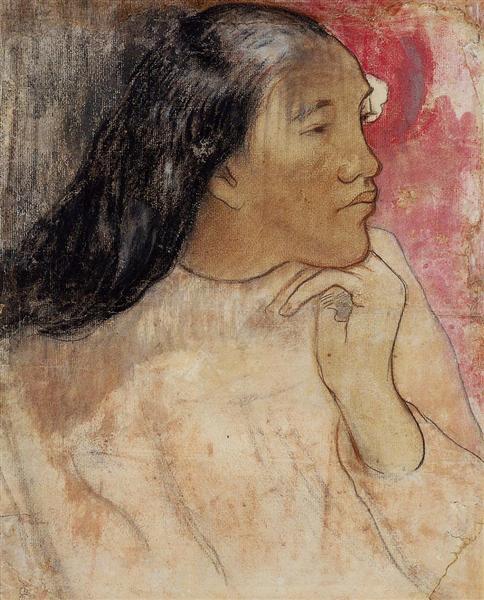תיאור
Paul Gauguin's Tahitian Woman with a Flower in Her Hair, created in 1891, is a prime example of the celebrated post-impressionist artist's distinctive style and his search for the essence of primitive life, as well as his fascination with the exoticism of Polynesian cultures. The painting depicts a Tahitian woman, whose serene and contemplative face evokes a deep connection with nature and the spirituality of her surroundings.
In this work, Gauguin uses a palette of vibrant and saturated colors that enhances the beauty of the central figure. The intense shades of green, pink and yellow contrast with the dark skin of the woman, who appears as a symbol of fertility and connection with the earth. The use of a purely decorative background, which is often associated with Gauguin's style, makes the figure stand out in an almost warlike manner, framing her in an environment where the harmony between the woman and nature predominates.
The woman, with a white flower in her hair, is the undisputed focus of the composition. Her introspective gaze invites the viewer to reflect on her inner world and her understanding of life. Through this depiction, Gauguin not only celebrates the physical beauty of the female figure, but also reveals the personality and identity of the Tahitian woman, whose daily life and spirituality were of great interest to the European artist.
The work is set in the context of the period when Gauguin spent time in Tahiti, moving away from European life and its frenetic modernity. This search for the “primitive” was both an attempt to escape and an exploration of simpler, more essential values. Gauguin sought to communicate a sense of peace and connection with the landscape, attributes that he believes had been lost in his Western culture.
Stylistically, "Tahitian Woman with a Flower in Her Hair" shares similarities with other works by Gauguin that involve indigenous figures, such as "The Origin of the World" and "The Vision after the Sermon." In all of these works, the artist explores not only the human figure, but also the symbolism of colors and shapes, using abstraction as a means to convey emotions that go beyond the tangible.
It is interesting to note how the symbolism of colour is fundamental in this work. The white flower in her hair can be interpreted not only as a decorative element, but also as a symbol of purity and femininity. The predominance of green, which stands out in the background, not only acts as a backdrop, but also suggests fertility and life, reinforcing the symbiotic relationship between the woman and her environment.
Through “Tahitian Woman with a Flower in her Hair,” Gauguin not only captures the essence of a Tahitian woman, but also offers a commentary on the beauty and spirituality he perceived in the South Pacific. His unique style, with its fusion of traditional pictorial representation and modernist innovation, remains a source of inspiration for artists and art lovers alike. This work stands as a testament to the evocative power of the image and to art’s ability to transcend cultural and temporal boundaries.
KUADROS ©, a famous painting on your wall.
Hand-made oil painting reproductions, with the quality of professional artists and the distinctive seal of KUADROS ©.
Painting reproduction service with satisfaction guarantee. If you are not completely satisfied with the replica of your painting, we will refund 100% of your money.

